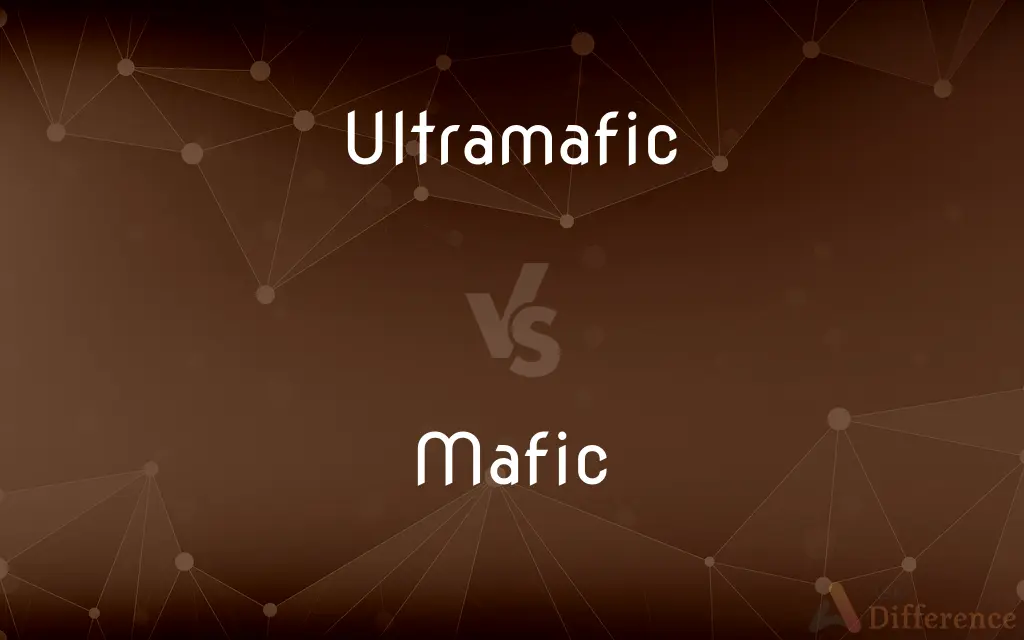Ultramafic vs. Mafic — What's the Difference?
By Fiza Rafique & Maham Liaqat — Updated on April 5, 2024
Ultramafic rocks have more than 90% mafic minerals, characterized by high magnesium and iron, while mafic rocks are less rich, with 45-55% silica content.

Difference Between Ultramafic and Mafic
Table of Contents
ADVERTISEMENT
Key Differences
Ultramafic rocks are known for their high magnesium and iron content, making them darker and denser. These rocks typically contain more than 90% mafic minerals, which include olivine and pyroxene. On the other hand, mafic rocks, while also rich in magnesium and iron, have a slightly higher silica content (45-55%) and include minerals like pyroxene, amphibole, and plagioclase feldspar. This difference in composition influences not only their color and density but also their location and formation processes.
Ultramafic rocks are often found in the Earth's mantle and at tectonic plate boundaries, indicating their formation from very high pressure and temperature conditions. Whereas, mafic rocks are more commonly found in the Earth's crust, particularly at divergent plate boundaries like mid-ocean ridges, where they form from partial melting of the upper mantle.
The presence of ultramafic rocks on the Earth's surface is relatively rare compared to mafic rocks, as their formation and exposure are linked to specific tectonic events, such as the obduction of oceanic lithosphere. Mafic rocks, however, are more abundant on the surface, forming features like basaltic ocean floors and volcanic islands.
Ultramafic rocks, due to their deep origin, are important in studies related to the Earth's mantle composition and the dynamics of mantle convection. Mafic rocks, with their widespread presence on the crust, provide insights into volcanic activities and the cycling of materials between the Earth's interior and surface.
While ultramafic rocks are mostly composed of olivine and orthopyroxene, giving them a greenish or dark color, mafic rocks have a wider range of minerals including olivine, pyroxene, amphibole, and biotite, leading to a variety of colors from dark green to black.
ADVERTISEMENT
Comparison Chart
Silica Content
Less than 45%
45-55%
Mineral Composition
Mainly olivine and pyroxene
Pyroxene, amphibole, plagioclase feldspar
Density
Higher
Lower than ultramafic, but still dense
Color
Dark, often greenish
Dark, varies from green to black
Common Locations
Earth's mantle, obducted lithosphere
Earth's crust, mid-ocean ridges
Compare with Definitions
Ultramafic
Rocks composed mostly of mafic minerals with more than 90% mafic content.
Peridotite, a type of ultramafic rock, is abundant in the Earth's mantle.
Mafic
Rocks with 45-55% silica content and rich in magnesium and iron.
Basalt is a common mafic rock found on ocean floors.
Ultramafic
High in magnesium and iron, low in silica.
Dunite is an ultramafic rock that is mostly made up of olivine.
Mafic
Forms from partial melting of the mantle.
Mid-ocean ridge basalts (MORB) are mafic rocks formed at divergent boundaries.
Ultramafic
Dense and dark-colored, often with a greenish tinge.
Ultramafic rocks, like komatiite, are typically dark and dense with a greenish hue.
Mafic
Composed of minerals like pyroxene, amphibole, and plagioclase.
Gabbro, a coarse-grained mafic rock, contains pyroxene and plagioclase.
Ultramafic
Rare on the Earth's surface, indicates significant tectonic activity.
The exposure of ultramafic rocks at the surface often signals the presence of ancient tectonic plates.
Mafic
Widespread on the Earth's crust, associated with volcanic activity.
Mafic lava flows are common features of volcanic islands.
Ultramafic
Important for studying the Earth's mantle composition.
Studies of ultramafic rocks provide insights into the composition and dynamics of the mantle.
Mafic
Provides insights into volcanic processes and crust formation.
The study of mafic rocks helps in understanding the formation of the oceanic crust.
Ultramafic
Ultrabasic.
Mafic
A mafic mineral or rock is a silicate mineral or igneous rock rich in magnesium and iron. Most mafic minerals are dark in color, and common rock-forming mafic minerals include olivine, pyroxene, amphibole, and biotite.
Ultramafic
(geology) Describing igneous rocks that contain magnesium and iron and only a very small amount of silica, such as are found in the Earth’s mantle.
Mafic
Relating to or containing a group of dark-colored silicate minerals, composed chiefly of magnesium and iron, that occur in igneous rocks, including hornblende, pyroxene, olivine, and biotite.
Ultramafic
A rock with such properties.
Mafic
(geology) Describing rocks, such as silicate minerals, magmas, and volcanic and intrusive igneous rocks, which contain relatively high concentrations of magnesium and iron.
Mafic
A rock with such properties.
Common Curiosities
Why are ultramafic rocks rare on the Earth's surface?
Their presence on the surface is usually due to specific tectonic processes that expose deep-seated rocks, making them relatively rare.
What defines a rock as ultramafic?
Ultramafic rocks are defined by their composition of more than 90% mafic minerals, high in magnesium and iron, and low in silica.
Where are ultramafic rocks typically found?
They are primarily found in the Earth's mantle and at sites of obducted lithosphere.
What is the main difference between ultramafic and mafic rocks?
The main difference lies in their silica content and mineral composition, with ultramafic rocks having less silica and a higher proportion of mafic minerals.
Can ultramafic rocks be used to study the Earth's interior?
Yes, their composition and formation provide valuable insights into the Earth's mantle and tectonic history.
How does the density of ultramafic rocks compare to mafic rocks?
Ultramafic rocks are denser than mafic rocks due to their higher content of magnesium and iron.
How do the colors of ultramafic and mafic rocks differ?
Ultramafic rocks are generally darker and often have a greenish tinge, while mafic rocks vary from dark green to black.
How do mafic rocks form?
Mafic rocks form from the partial melting of the mantle, especially at divergent plate boundaries and hotspots.
What is the significance of mafic rocks in geology?
Mafic rocks are key to understanding volcanic activity, crust formation, and the cycling of materials between the Earth's surface and interior.
Why are mafic rocks important for studying volcanic processes?
Their formation and composition provide clues about the nature of volcanic eruptions and the evolution of the Earth's crust.
Are there any environmental implications of ultramafic rocks?
Ultramafic rocks can influence soil chemistry and vegetation due to their unique mineral composition.
Can ultramafic rocks be found in continental crust?
Yes, though rare, they can be found in continental crust, often associated with ancient tectonic events.
How does the formation of ultramafic rocks differ from mafic rocks?
Ultramafic rocks form under higher pressure and temperature conditions, often deep within the Earth, while mafic rocks form from partial melting of the mantle at shallower depths.
What role do mafic rocks play in the oceanic crust?
Mafic rocks, like basalt, constitute a major part of the oceanic crust, formed at mid-ocean ridges.
What minerals are commonly found in ultramafic rocks?
Olivine and pyroxene are the dominant minerals in ultramafic rocks.
Share Your Discovery

Previous Comparison
Pinecone vs. Acorn
Next Comparison
Sharing vs. ShareAuthor Spotlight
Written by
Fiza RafiqueFiza Rafique is a skilled content writer at AskDifference.com, where she meticulously refines and enhances written pieces. Drawing from her vast editorial expertise, Fiza ensures clarity, accuracy, and precision in every article. Passionate about language, she continually seeks to elevate the quality of content for readers worldwide.
Co-written by
Maham Liaqat















































